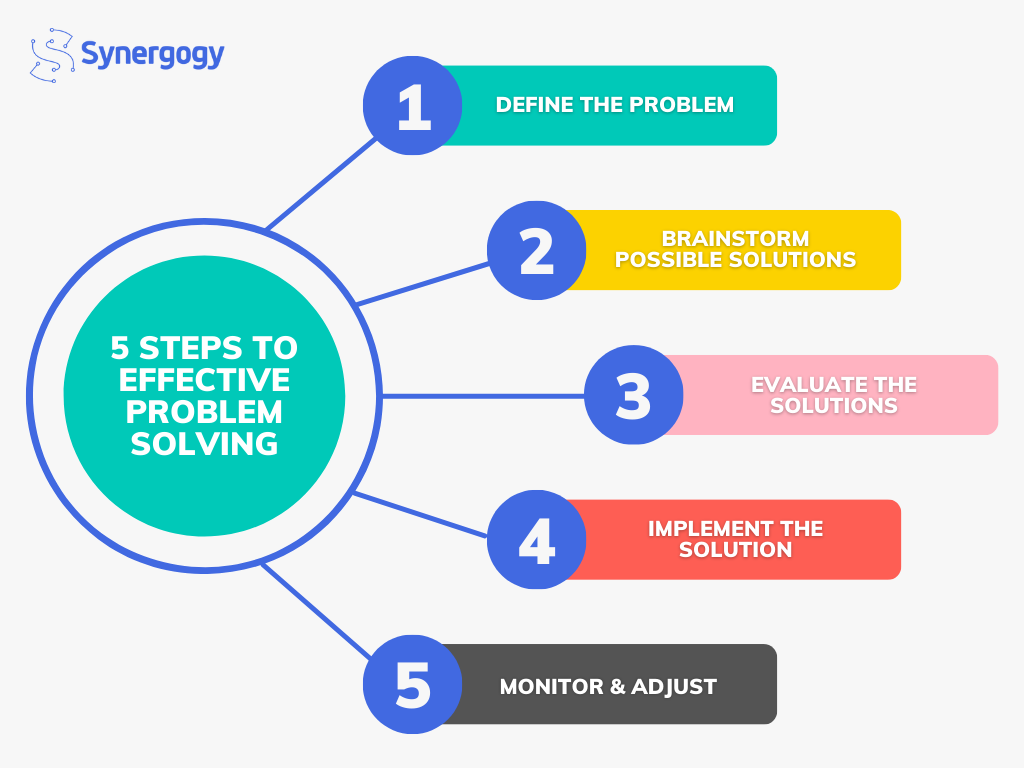5 Simple Steps to Effective Problem Solving

The ability to solve problems is a crucial skill in the modern workplace. It can make the difference between success and failure, and it can help you navigate the complexities of a fast-paced environment. But what exactly is effective problem solving? And how can you develop the skills needed to solve problems efficiently and effectively?
Effective problem solving involves several key steps that can help you identify the root cause of a problem, develop a plan of action, and implement that plan to achieve a successful outcome. Here are five simple steps you can take to develop your problem-solving skills and tackle any challenge that comes your way in the workplace.
Introduction
Have you ever found yourself in a situation where you’re faced with a workplace problem, and you’re not sure where to start? Whether it’s a customer complaint, a team conflict, or a project delay, it’s essential to address it promptly to maintain productivity and morale. In this article, we’ll provide practical steps that can help you effectively solve problems at your workplace.

Step 1: Define the Problem
The first step in effective problem solving is to define the problem clearly. Take the time to analyze the issue and gather as much information as possible. It’s crucial to identify the cause of the problem and its impact on your team or organization. For example, if a team member is underperforming, it’s essential to understand the root cause of the issue and how it’s affecting the team’s productivity. Is it a lack of training, motivation, or resources? Are there external factors, such as personal issues or workload, that are affecting their performance?
Once you have a clear understanding of the problem, you can begin to develop a plan of action to address it. It’s important to involve all stakeholders in this process, including those who are directly affected by the problem, to ensure that you have a complete picture of the situation. Involving others in the process can also help you gain different perspectives and insights, which can be valuable in developing an effective solution.
Step 2: Brainstorm Possible Solutions
After identifying the problem, the next step is to brainstorm possible solutions. It’s important to be creative and come up with as many solutions as possible, even if they seem unrealistic or impractical. Brainstorming can be done individually or in a group setting, where team members can bounce ideas off each other. In a group setting, it’s important to create an open and safe environment where everyone feels comfortable sharing their ideas. Remember to focus on generating ideas, without evaluating or criticizing them during the brainstorming session.
Once you have a list of possible solutions, evaluate each one based on their feasibility, potential impact, and costs. It’s important to consider the pros and cons of each solution before selecting the most appropriate one. Keep in mind that the solution may not be perfect, but it should be the best one available given the resources and constraints. By considering different options, you can increase the chances of finding an effective solution that addresses the problem.
Step 3: Evaluate the Solutions
When evaluating the solutions, it’s important to keep an open mind and consider different perspectives. Seek feedback from other team members or colleagues who may have a different point of view. It’s also important to consider the long-term effects of each solution, rather than just the immediate impact. For instance, while changing the project scope may seem like a quick fix to a delayed project, it could cause further delays or even impact the project’s success in the long run.
During the evaluation process, it’s essential to prioritize solutions based on their impact on the problem and their feasibility. Consider the resources, time, and effort required to implement each solution. Some solutions may be quick fixes that can be implemented immediately, while others may require more planning and preparation. It’s important to choose a solution that addresses the problem effectively while also being feasible to implement within the given resources and timeframe.
It’s also important to remember that not all solutions may work as expected. Be prepared to modify or pivot to a different solution if the initial solution does not yield the desired results. Additionally, ensure that the chosen solution aligns with the company’s policies and values and does not violate any ethical standards.
Step 4: Implement the Solution
Implementing the chosen solution requires careful planning and execution. The team needs to work together to ensure that the solution is implemented smoothly and efficiently. The plan should include a timeline, specific tasks, and deadlines. Assigning roles and responsibilities to each team member is crucial to ensure that everyone understands their role in the implementation process.
Effective communication is also essential during the implementation phase. The team should communicate regularly to discuss progress, identify any obstacles, and adjust the plan if necessary. For example, if the team decides to implement a new customer service strategy, they should train the customer service team, provide them with the necessary tools, and communicate the new strategy to customers.
It’s also important to track the progress of the implementation to ensure that everything is on track. Regular check-ins can help identify any problems early on and provide an opportunity to address them before they become bigger issues.
Step 5: Monitor and Adjust
Monitoring and adjusting the solution is crucial in ensuring that the problem is fully resolved. It’s essential to track the progress of the solution and evaluate its effectiveness. If the solution is not working as planned, it’s important to adjust it accordingly. This step requires flexibility and open communication among team members.
For example, if the team decided to adjust the project timeline, they should monitor the progress regularly and make adjustments if necessary. They should also communicate any changes to the stakeholders involved in the project. If the new timeline is not working, the team should be open to making further adjustments, such as revising the project scope or adding more resources.
Feedback plays a vital role in this step. It’s important to gather feedback from team members and stakeholders to ensure that the solution is meeting their needs. Feedback can also help identify any potential issues that may arise and allow the team to address them promptly.
Learning from mistakes is also an important aspect of effective problem solving. Every problem presents an opportunity to learn and grow. By reflecting on the process and the outcome, team members can identify areas for improvement and apply them in future problem-solving situations.
Conclusion
So, there you have it – a five-step process to solve any workplace problem like a pro! Whether it’s a pesky customer complaint, a tricky team conflict, or a stubborn project delay, you can tackle it with ease.
Remember, the first step is to define the problem – analyze it, gather information, and understand the root cause. Next, brainstorm possible solutions, even if they seem unrealistic or impractical. Get creative and come up with as many solutions as possible!
After that, evaluate the solutions by identifying their pros and cons, and choose the one that’s most feasible and practical. Make sure to consider the potential risks and benefits of each solution. Then, it’s time to implement the most practical solution. Develop a plan, communicate it to everyone involved, and assign roles and responsibilities.
Last but not least, monitor the progress and adjust the solution if necessary. Keep track of the progress and be open to feedback. Remember, learning from your mistakes is the key to success!
So, the next time you face a workplace problem, take a deep breath and follow these simple steps. You’ll be able to find a solution that works for everyone and become a valuable asset to your team or organization. With effective problem solving skills, you can maintain productivity, boost morale, and achieve success!
Learn more about Problem Solving at the Workplace: 5 Simple Steps to Effective Problem Solving